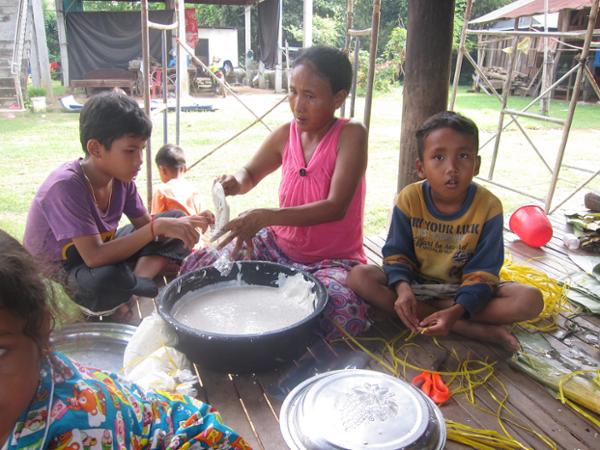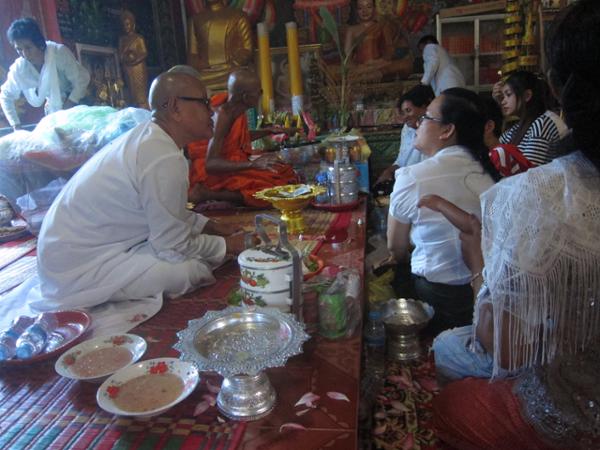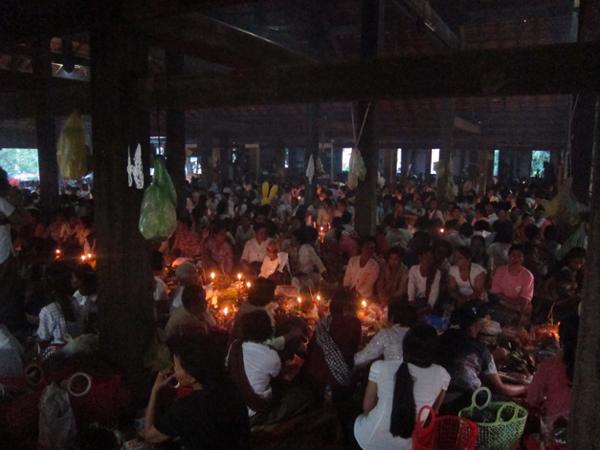
The art of cooking for the damned
During Pchum Ben, Phnom Penh empties out, allowing rural villages to repopulate for an extended weekend. In Troh Per Lek, in Kampong Speu province, aprons are donned for a religious celebration that undoubtedly requires great culinary skills.
The Phnom Penh concrete jungle gives way to banana trees, palm trees, and other coconut palms. The asphalt, sometimes dry, sometimes flooded, becomes dusty dirt roads. The air, once heavily polluted, is now fresh with oxygen. Settled on what she calls a bed, which resembles more of a wooden table, Srey prepares two of the five Khmer rice cakes inseparable from Pchum Ben. They are akin to Christmas logs in the West.
Cuisine: The beacon of the ancestor festival
The first is called nom mok or nom jeal. Call it what you will; its name varies across Cambodia. Pain au chocolat or chocolatine? But without the ego trip. Shielded from the sharp rays of the sun under the porch of her stilted house, the woman in her forties energetically works her rice paste. "The most crucial part of the nom mok recipe is ensuring the mixture sets perfectly," she explains, hands deep in the black basin. After grinding the rice to obtain powder, it must be moistened and sweetened. If this step is missed, the cake will be inedible. The cook adds a cereal called ngor, previously pan-fried "to bring out the flavor," adds Kunthea, Srey's young cousin. After a long mixing process, the pastry chef struggles to ladle the thick rice paste into plastic pouches. Off to the double boiler in the cauldron.

(Srey completes the preparation of nom mok)
Borin sits beside her. The father wraps the second preparation, on som chek, in banana leaves. The other Khmer rice cake the extended family prepares this weekend. In Troh Per Lek, this property houses four elevated houses. All its residents know each other well; they live together constantly. And they are not alone. Borin prepares his bouquets of garnishes, watched by roosters, hens, dogs, and cats. The cows return to the stable, five meters away. "The rice has rested for four hours in cold water before being placed on this leaf as the first layer. I add a bean puree, on which I place meat, it doesn't matter, here it's chicken. Raw. It will cook in the double boiler too," he specifies, tying up one of his creations.

(The on som chek cakes are kept warm)
Cuisine is an art that requires mastery with patience. Days pass before the celebration on Wednesday (October 10) marks the end of Pchum Ben. Everyone takes their time to prepare the pastries. They serve both family reunions and religious commemorations. "We must feed those who are no longer here," assures Sok, 83, the village elder.

(Sok’s family prepares to head to the pagoda)
Pchum Ben: fifteen days of grace
“We celebrate Pchum Ben to remember the names of our ancestors," he continues. "We believe that those who were good in their lives need nothing now where they are. For others, it's different. Pchum Ben is dedicated to granting them grace and food, because the rest of the year, they have nothing." Clemency accompanies families who gather each year to celebrate the ancestor festival. This link between past and present beings unfolds in the company of monks, at the pagoda.

(At the pagoda, offerings abound. The on som chek, wrapped in banana leaves, surround the nom mok, safely tucked in plastic bags)
The atmosphere changes upon entering the village temple. The impression of entering a sterile room. The smell is different, much more neutral, although families enter carrying many dishes to offer to the monks. The view becomes uniform. White dominates. A large majority of devotees wear immaculate tops. At the first steps, only the prayers and blessings of the monks, amplified by speakers, reach the ears. Four nuns smile valiantly, making one want to listen to them, to sit by their side. Then it all fades. "Don't worry, the white clothes are just a traditional dress style. Look, not everyone follows, it's not mandatory." Indeed. Breton stripes and French national team jerseys walk through the crowd. Families come to offer Khmer cakes and other local dishes to the monks who connect with the dead. The damned. Those who misbehaved in their lives.

(The devotees offer meals to the monks, so that they may pass them on to the damned.)
Hundreds of devotees now populate the Troh Per Lek pagoda, each following the same path. They queue and wait their turn to present the dishes they've prepared, accompanied by a few 100 riel bills, each worth two cents.

(A line forms inside the pagoda as devotees bring food offerings to the monks.)
Pchum Ben reunites Khmer families every year, often separated between big cities and the countryside. Amidst smiles, dialogues, and feasts, they all find joy in spending time with their loved ones. All with the goal of donning their aprons to offer the damned the meals of the country's largest religious festival.

(Hundreds of devotees pray as night falls.)
Thibault Bourru